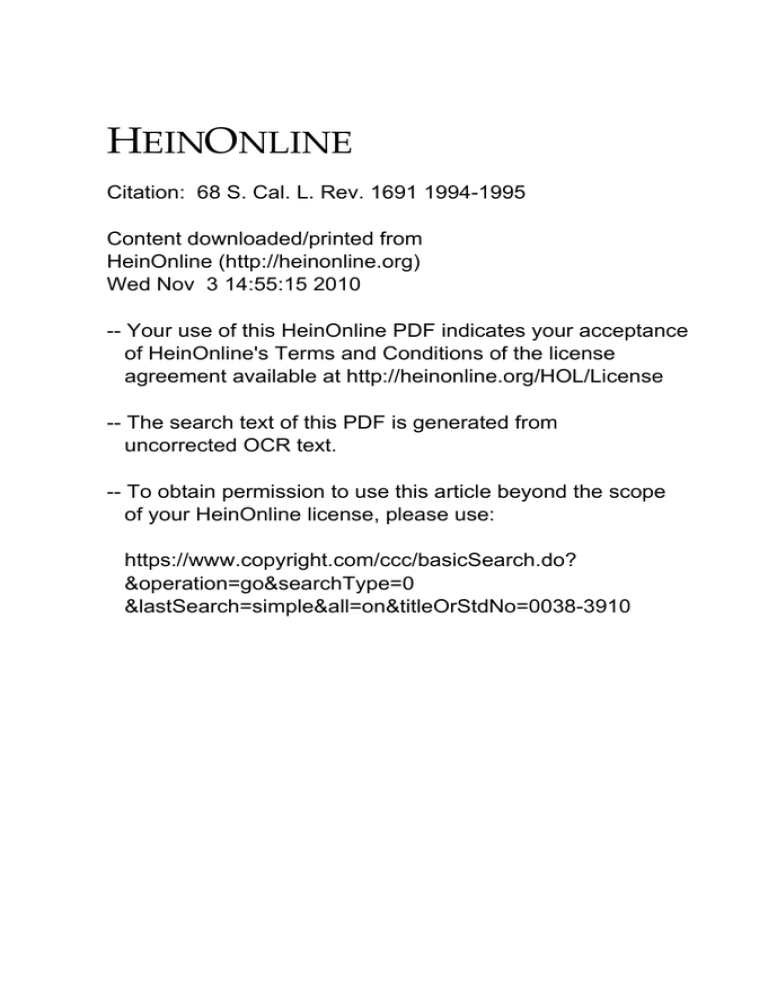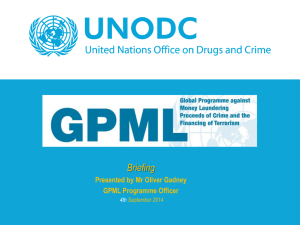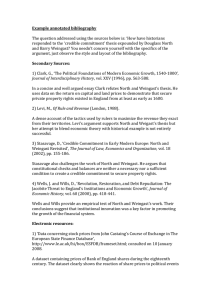+ 2 (,1 1/,1(
advertisement

+(,121/,1( Citation: 68 S. Cal. L. Rev. 1691 1994-1995 Content downloaded/printed from HeinOnline (http://heinonline.org) Wed Nov 3 14:55:15 2010 -- Your use of this HeinOnline PDF indicates your acceptance of HeinOnline's Terms and Conditions of the license agreement available at http://heinonline.org/HOL/License -- The search text of this PDF is generated from uncorrected OCR text. -- To obtain permission to use this article beyond the scope of your HeinOnline license, please use: https://www.copyright.com/ccc/basicSearch.do? &operation=go&searchType=0 &lastSearch=simple&all=on&titleOrStdNo=0038-3910 NEGATIVE POLITICAL THEORY* PAMELA S. KARLAN** & DANIEL R. ORTIzt Sometimes it is hard to be positive about positive political theory ("PPT"). In some hands, PPT elevates "theory," or at least simple models, over the messy realities of politics. It is hard to be positive (as in "confident") about PPT's claims when a richer factual account would lead to a dramatically different understanding of how the political process actually operates. Furthermore, PPT's claim of an "objective" account of how political institutions actually work' often serves as little more than a prologue for an assertion that understanding how laws are made tells us how they ought to be made or ought to be interpreted. It is hard to be positive (as in "non-normative" 2 ) when a PPT proponent uses PPT to generate prescriptive proposals. It is hard, in short, to be positive (as in "favorably inclined") toward a theory that often gets its analytic power from its descriptive and jurisprudential thinness. I. A POSITIVE ACCOUNT OF RODRIGUEZ AND WEINGAST'S PAPER Daniel Rodriguez and Barry Weingast offered one particularly detailed account of how PPT should inform courts' use of legislative * This Comment responds to a paper by Daniel B. Rodriguez and Barry R. Weingast, Legislative Rhetoric, Statutory Interpretation, and the History of the 1964 Civil Rights Act, which was presented by the authors at the Positive Political Theory and Law Symposium in May 1995. As this issue went to press, the paper was unavailable for publication. This Comment is based on arguments in the version of the paper presented at the Symposium and in a subsequent revised draft. ** Professor of Law and Roy L. and Rosamond Woodruff Morgan Research Professor of Law, University of Virginia. t Professor of Law, University of Virginia; Visiting Professor of Law, University of Southern California. We thank Christy Lillquist for her research assistance. 1. McNollgast, Positive Canons: The Role of Legislative Bargains in Statutory Interpretation, 80 GEo. L. 705, 706 (1992). 2. Daniel A. Farber & Philip P. Frickey, Foreword. Positive Political Theory in the Nineties, 80 GEo. L.J. 457, 462 (1992). 1691 HeinOnline -- 68 S. Cal. L. Rev. 1691 1994-1995 1692 SOUTHERN CALIFORNIA LAW REVIEW [Vol. 68:1691 history.3 Their project starts from a normative premise: Courts construing statutes should enforce the contract forged in the legislative process.' PPT permits courts to better understand this process and thus to better recover the original terms of the legislative bargain. As Rodriguez and Weingast put it: "[O]ne needs to have a theory of how legislation gets made in order to understand how to extract the 'meaning' of legislation through the process of interpretation."'5 Grasping the "industrial organization" of Congress 6 provides valuable insights 3. Daniel B. Rodriguez & Barry R. Weingast, Legislative Rhetoric, Statutory Interpretation, and the History of the 1964 Civil Rights Act (1995) (unpublished paper on file with the authors). Our Comment was prepared originally as a response to Rodriguez and Weingast's presentation at the live Symposium. Rodriguez and Weingast's paper is essentially an illustration of a PPT methodology developed in Weingast's earlier work, see, e.g., McNollgast, supra note 1. It applies that method to the question of how to interpret Title VII of the Civil Rights Act of 1964. Our criticism, while it relies on examples from civil rights legislation, responds to more general problems-both positive and normative-with PPT. Thus, just as Rodriguez and Weingast's paper offers an application of a methodology, our paper offers an application of what we believe is a more generalizable set of problems with PPT. While there certainly are distinctive problems with applying PPT to the 1964 Act, which we discuss infra at text accompanying notes 29-34, we believe that there are also more widespread difficulties with PPT which a careful consideration of Rodriguez and Weingast's attempted application reveal. 4. Apparently aware of the dangers into which this normative premise may lead, Rodriguez and Weingast try to back off from it in their introduction. Rodriguez & Weingast, supra note 3. Thus, they describe their project early on as "not argu[ing] that fidelity to the statute ought to be the paramount or principal goal of statutory interpretation ...." Id. (emphasis added). Rather, they characterize their project as offering the best way to "recove[r]" "the statute's original meaning," id., and purport to leave it to others to decide what role that meaning should play in statutory interpretation, id. This is disingenuous. At other places in the paper they state their working premise-that the compromise as actually forged in the legislative process "represents the statute whose meaning the process of statutory interpretation is concerned with recovering." Id. And, more honestly, they later admit the actual premise they struggle so hard in the introduction to deny: Ultimately, this analysis requires a normative basis. That is, the lessons for interpretation provided by our positive account of legislative decisionmaking and rhetoric turn squarely upon what one regards as the essential project of statutory interpretation.... [W]e insistthat the projectmust be about the determinationof legislative meaning recovered from the expressed and, where appropriate, unexpressed intent of the framers of the statute. Id (emphasis added). The real test, of course, lies in the application. Here they do what they so strongly deny doing in the introduction. They use the statute's original meaning, as they reconstruct it, to offer a normative critique of the Court's interpretations of the central provisions of the Civil Rights Act. Indeed, to their minds, "the intent of the legislators whose support was critical to forging the coalition necessary to pass the bill" forms the "baseline" from which to measure the validity of the Court's decisions. Id. In any event, they are hard put to deny that their project's central ambition is to champion a contractualist view of legislation. Indeed, their innovation lies only in the way they argue we should recover the terms of these public "contracts." 5. Id. 6. Id. HeinOnline -- 68 S. Cal. L. Rev. 1692 1994-1995 1995] NEGATIVE POLITICAL THEORY 1693 into how the legislative process works and how courts should understand its output. In Rodriguez and Weingast's account, the legislative world is divided, like Gaul, into three parts. First, there are the "ardent supporters" of a proposed bill; second, there are the "ardent opponents"; finally, there is a moderate, "pivotal," bloc. 7 Since on most legislation of any importance ardent supporters do not constitute an effective majority, the pivotal bloc provides the critical votes for a bill's passage. In light of this tripartite classification, Rodriguez and Weingast make two claims about legislative history. First, an intentionalist interpretation of legislative history should give great, perhaps decisive, weight to the understanding of the bill offered by the pivotal voters.. Second, this classification gives courts a tool for filtering out "manipulate[d]" and "manufacture[d]" legislative history. 9 In looking at the information generated by legislators, Rodriguez and Weingast identify several distinct types of communications. Both ardent supporters and ardent opponents may engage in "cheap talk."'1 The ardent supporters may engage in puffery or after-the-fact reminiscences designed to advance an unduly expansive interpretation of the law." The ardent opponents, by contrast, may offer a parade of horribles to deter moderates from supporting the legislation. Needless to say, Rodriguez and Weingast argue that courts should deeply discount cheap talk. They contrast cheap talk with contemporaneous "costly signalling," that is, concessions made by ardent supporters to 13 attract pivotal support.12 Like statements against interest, costly signals possess important indicia of reliability since they reveal what ardent supporters think pivotal voters would require in order to support the bill. Finally, and this is the category of communications that Rodriguez and Weingast find most probative of the legislature's intent, there are statements and proposals made by pivotal legislators. 4 7. Id. arguing in essence "that a statute's meaning may be recovered by careful atten8. See id., tion to the dimensions of the final compromise struck among legislators whose support [was] necessary for the passage of the final bill". This is what Farber and Frickey mean with their reference to "The Triumph of the Median Voter." Farber & Frickey, supra note 2, at 473. 9. Rodriguez & Weingast, supra note 3. 10. Id. 11. Id. 12. Id. 13. See FED. R. Evm. 804(b)(3). 14. Rodriguez & Weingast, supra note 3. HeinOnline -- 68 S. Cal. L. Rev. 1693 1994-1995 1694 SOUTHERN CALIFORNIA LAW REVIEW [Vol. 68:1691 These statements and proposals are central to the task of asking "what the critical legislators, working within the rules and structures of legislative institutions, understood to be the agreement reached in the final version of the law."'15 Much of Rodriguez and Weingast's paper is taken up with an application of their model to the Civil Rights Act of 1964.16 Here, PPT plays two roles. The first is largely descriptive. As PPT would predict, the House of Representatives passed a bill designed to have strong bipartisan support because such a bill would fare better in the Senate, whose industrial organization (in particular, the requirement of a supermajority for cloture) required an appeal to moderates as well as to ardent supporters of civil rights. Then, in the Senate, the votes of a pivotal coalition led by Senate Minority Leader Everett Dirksen were necessary to the passage of any bill,17 and Dirksen offered a variety of amendments and understandings of the bill.' 8 Thus, and here PPT plays a second, normative role, Rodriguez and Weingast argue that Dirksen's pivotal position means that his interpretation of the Act's scope should control. 19 They criticize the Supreme Court for failing to give sufficient weight to Dirksen's views, and for failing to recognize the cheapness of the talk of senators such as Hubert Humphrey, Joseph Clark, and Clifford Case, all ardent supporters, whose expansive views the Court ultimately adopted. 20 II. SOME NORMATIVE HOLES IN POSITIVE THEORY Rodriguez and Weingast demand much more from PPT than it can possibly give them. In their account, PPT offers not only a description of how legislators produce statutory language, but a prescription for how courts should interpret legislative rhetoric as well. This second step, however, in no way follows from the first. A description of how legislators actually behave may tell us much about ourselves and our institutions but, by itself, can have no prescriptive consequences. To generate prescriptions for how political institutions (such as courts) should behave, we must combine any description PPT gives 15. Id. 16. U.S.C.). 17. 18. 19. 20. Pub. L. No. 88-352,78 Stat. 241 (1964) (codified as amended in scattered sections of 42 Rodriguez & Weingast, supra note 3. See id. Id. Id. HeinOnline -- 68 S. Cal. L. Rev. 1694 1994-1995 1995] NEGATIVE POLITICAL THEORY 1695 us with a robust normative theory. But then it is the normative theory, not the description, that does all the heavy lifting. Rodriguez and Weingast's central descriptive insight is undeniably correct: Congress' industrial organization does allocate power to determine statutory language unequally across legislators. This is uncontroversial. Members of the committee to which a bill is assigned, for example, will have a much greater say over its language than will other legislators. But why should courts in interpreting legislative rhetoric automatically replicate this allocation, especially if the allocation may represent a pathology in the democratic process? Rodriguez and Weingast give no answer. Presumably, they believe that the questions of how political institutions do operate and how they should operate are the same - "Whatever is, is right."'" PPT can help us with the first, descriptive, question only. To answer the second, we must turn elsewhere-to normative democratic theory. Only such a perspective can tell us what we want our institutions to do-a question prior to whether they are actually performing as we want them to perform. Rodriguez and Weingast's method thus proceeds backwards. They first describe how the legislature actually produces statutory language and then prescribe that courts interpret legislative rhetoric, a distinct activity, so as to perpetuate the dynamic of the first process. They jump from an "is" in one process to an "ought" in another. Their method holds two dangers: At the least it may deny us an opportunity to correct a pathology in the democratic process and at the worst it may add to the original pathology by amplifying its effects through other political practices. This gap between positive and normative analyses leaves all of Rodriguez and Weingast's prescriptions without support. One could, in fact, accept their descriptive analysis and easily come to prescriptive conclusions exactly the opposite of theirs. Someone who believed, for example, that a particular legislative pivot had decisive power in determining a statute's language but that such power was democratically inappropriate could argue against giving the pivot's legislative rhetoric decisive weight as against the views of others. Weighing others' voices more heavily might better satisfy the demands of democratic theory. 2 21. III TiH POEMS OF ALEXANDER POPE, AN ESSAY ON MAN, epistle i, at 51, 1. 294 (Methuen & Co. ed. 1950) (1733). 22. We are not suggesting that courts should make judgments like this in particular cases, but rather that they may aim to achieve ends like these in developing general rules for interpreting legislative rhetoric. Cf. Jonathan R. Macey, Promoting Public-Regarding Legislation Through Statutory Interpretation:An Interest Group Model, 86 COLUM. L. REv. 223, 261-66 HeinOnline -- 68 S. Cal. L. Rev. 1695 1994-1995 1696 SOUTHERN CALIFORNIA LAW REVIEW [Vol. 68:1691 Consider how Rodriguez and Weingast would have courts interpret the legislative rhetoric of dictators like House Speakers Cannon 3 According to Rodriguez and Weingast, and Reed.2 the more absolute a dictator's power in the legislature-in other words, the less democratic the dictator is-the more courts should discard the legislative rhetoric of all other legislators. Such an approach would, to be sure, replicate the original bargaining dynamic, but would it be democratic? Would a court taking this approach not, in fact, reward subversion of the democratic process by making such subversion more complete? The dictator would now enjoy control over not only the statutory language but also the legislative history. In short, PPT may help us describe the political process, but it cannot tell us whether to respect or correct what we find there. To decide that, we must look to normative democratic theory, III. SOME POSITIVE HOLES IN POSITIVE THEORY Even more surprising given the methodology of their paper, Rodriguez and Weingast fail to justify their treatment of legislative rhetoric according to PPT itself. Although they do offer a PPT account of how legislatures produce statutory language, they offer no such account for the production of legislative rhetoric. They simply assume that the political actors in the legislature would want courts to weigh a particular legislator's rhetoric according to that legislator's influence in framing the statutory language and to whether or not the rhetoric was "cheap." But would legislators want their rhetoric to count in this particular way? Put somewhat differently, suppose Congress were presented with a proposed "Proper Understanding of Legislative Rhetoric and Statutory Interpretation Act of 1995" that adopted Rodriguez and Weingast's proposals for how courts should assess cheap talk, costly signalling, and the actions and statements of pivotal legislators. Would the bill pass? If not, and we think passage would be unlikely, then Rodriguez and Weingast's analysis fails under PPT itself. (1986) (proposing rules of interpretation to combat pathologies of legislative process); Cass R. Sunstein, Interpreting Statutes in the Regulatory State, 103 HARV. L. REV. 405, 462-93 (1989) (same). 23. See GEORGE B. GALLOWAY, HisToRY OF THE HOUSE OF REPRESENTATIVES 167-69 (2d ed. 1976) (discussing the dominance of the Speaker of the House during the tenures of Reed and Cannon). HeinOnline -- 68 S. Cal. L. Rev. 1696 1994-1995 1995] NEGATIVE POLITICAL THEORY 1697 If Congress wanted courts to weigh legislative rhetoric the way Rodriguez and Weingast propose, it is odd, to say the least, that Congress has never considered instructing the courts to do so. This failure is especially surprising since Congress must be aware that courts routinely ignore the questions of who the pivotal voters were and what their understanding was. PPT would predict that Congress would at least try to ensure that courts followed the approach legislators wanted. Furthermore, the most recent instance in major civil rights legislation of Congress' trying to control the courts' use of legislative rhetoric argues directly against Rodriguez and Weingast's position. In passing the Civil Rights Act of 1991, the Senate amended the original bill to specify that a certain interpretive memorandum should constitute the exclusive legislative history for a much contested provision.2 4 The pivotal senators presumably agreed with this limitation of legislative history; otherwise the limitation would not have become law. The Senate pivots, however, disagreed with the interpretive memorandum itself, which was before them at the time they agreed to the statutory language limiting the legislative history to the memorandum. The pivots' own legislative rhetoric, in fact, directly contradicted the memorandum. 25 Their action is an example of pivots agreeing to instruct courts to ignore the pivots' own legislative rhetoric. This story holds two lessons. First, Congress' general failure to instruct the courts on how to interpret legislative rhetoric cannot be explained away by legislative inertia. Congress, surprisingly, sometimes does instruct them. Second, when Congress has instructed the courts, it has directed them away from, not towards, Rodriguez and Weingast's position. Their model rests on dicey assumptions. Another major piece of civil rights legislation, the 1982 amendments to the Voting Rights Act of 1965, tells a similar story. As the price of his support for this measure, Senator Dole, the leader of the pivotal bloc in the Senate, demanded that the bill's ardent supporters acquiesce in the so-called Dole compromise. 26 This compromise incorporated a "results" test, which the ardent supporters desperately wanted, but also specified, to the pivots' satisfaction, that nothing in 24. An Act to Amend the Civil Rights Act of 1964, Pub. L. No. 102-166, § 105(b), 105 Stat. 1071 (1991) (codified at 42 U.S.C. § 1981 (Supp. 1992)). 25. Compare 137 CONG. REr_ S15473 (daily ed. Oct. 30, 1991) ("[O]n all.., issues [other than burden-of-proofj this Act leaves existing law undisturbed.") (pivots' position) with 137 CONG. REC. S15277 (daily ed. Oct. 25, 1991) (act overrules Supreme Court interpretation of critical substantive terms of Title VII) (ardent supporters' position). 26. See MICHAEL PERTSCHUK, GiANT KiLLERs 177-78 (1986). HeinOnline -- 68 S. Cal. L. Rev. 1697 1994-1995 1698 SOUTHERN CALIFORNIA LAW REVIEW [Vol. 68:1691 the amended provision "establishes a right to have members of a protected class elected in numbers equal to their proportion in the population."2 7 It thus expanded, but only so far, one of the Voting Rights Act's two central provisions. How far exactly it expanded this provision depends upon how the tension between the results test and the antiproportionality provision is resolved. This is the provision's interpretive crux. Interestingly, however, once Senator Dole carefully worked out the compromise in the statutory language, he stood back knowing that ardent supporters had written the key sections of the 28 Senate Report, the provision's authoritative legislative history. It seems that it was not essential to Senator Dole to control the resolution of the tension he himself carefully created. As these two examples from civil rights legislation indicate, legislators, even pivotal legislators, view legislative rhetoric differently from Rodriguez and Weingast's assumption. To legislators, legislative rhetoric is not simply a tool that courts should use to uncover the views of the people who "made" the original statutory bargain. Rather, it is an independent means of influencing the law's development. The one does not necessarily track the other. Congress' industrial organization, in fact, allocates power over statutory language and over legislative rhetoric differently. Votes and voice are two different currencies, distributed very differently through the legislature, and are subject to very different exchange mechanisms. The House Rules Committee, for example, is, as Rodriguez and Weingast recognize, a powerful player.2 9 Although it originates no legislation, it determines how and when the House takes up legislation coming from most other committees. The Rules Committee can ease a bill's passage, make it more difficult, or block it entirely by 27. Pub. L. No. 97-205, § 3, 96 Stat. 131 (1982) (codified at 42 U.S.C. § 1973(b) (1988)). 28. Indeed, Senator Dole expressly rejected the claim that his views, as a pivotal legislator, should be entitled to greater weight than the Committee Report. See Motion for Leave to File and Brief of Senators Dennis DeConcini et al., as Amici Curiae in Support of Appellees at 14-15, 20-21, Thornburg v. Gingles, 478 U.S. 30 (1986) (No. 83-1968) ("[T]he Solicitor General... argues... that the Senate Report is not determinative of the intent of Congress, and attaches greater significance to the individual views of amici Senators Dole and Grassley .... These efforts are misguided on both factual and legal grounds.... Under fundamental tenets of statutory construction, Committee Reports are accorded the greatest weight ....[T]o give controlling effect to any legislator's remarks ...'would be to run too great a risk of permitting one member to override the intent of Congress.... " (quoting Monterey Coal Co. v. Federal Mine Safety & Health Review Comm'n, 743 F.2d 589, 598 (7th Cir. 1984))). 29. See Rodriguez & Weingast, supra note 3. HeinOnline -- 68 S. Cal. L. Rev. 1698 1994-1995 1995] NEGATIVE POLITICAL THEORY 1699 refusing to report the bill out.3" The Committee, however, has no power to write legislative history for any of the bills it considers. That power belongs to others, chiefly the committees to which bills are originally assigned. The very creation of the committee system, with its assignment of report drafting to committees, suggests that legislative history is created there,31 rather than by "Lone Rangers" on the floor. Perhaps Rodriguez and Weingast were partially misled by their choice of Title VII as their case study. Unlike the vast majority of legislation, Title VII generated no committee report-precisely because the normal lawmaking processes could not have produced a bill at all. Under these unique circumstances, the statements of individual legislators-cheap talk, costly signalling, or pivotal explication-gain in importance because the usual sources are silent.32 Rodriguez and Weingast's analysis, moreover, has a puzzling implication. Since PPT rests on the self-interested behavior of legislators, Rodriguez and Weingast's whole model must assume that most legislators do not want their rhetoric to count in most instances. But why would legislators disempower themselves so? Unless they believed that silencing their own rhetoric on legislation for which they were not pivotal would increase their influence on the legislation for which they were and that the legislation for which they were pivotal would be particularly important to their constituents, they presumably would not disempower themselves in this way. Rodriguez and Weingast offer no argument, however, for why a legislator might believe this. In fact, the industrial organization of Congress argues otherwise. Since legislators often seek assignment to committees with jurisdiction over matters of special concern to their constituents, they would presumably want the legislative rhetoric produced by the committee to count for much and the legislative rhetoric produced by others, including many pivots, to count for less. Indeed, this sums up current judicial practice. 30. Only a discharge petition signed by a majority of the members of the House can dislodge a bill from the Rules Committee. RuLEs OF THE HousE OF REPREsENTATvFS, 102d Cong., 2d Sess., Rule XXVII, § 908 at 700-01 (rev. ed. Oct. 5, 1992). 31. See, e-g., Thomburg v. Gingles, 478 U.S. 30,43 n.7 (1986) (finding that the Senate Report accompanying the 1982 amendments to the Voting Rights Act is an "authoritative source" for determining congressional intent). 32. Cf. North Haven Bd. of Educ. v. Bell, 456 U.S. 512, 526-27 (1982) (finding the statements of Title IX's sponsor particularly important because the addition on the floor of the particular provisions meant that there was no committee report). HeinOnline -- 68 S. Cal. L. Rev. 1699 1994-1995 SOUTHERN CALIFORNIA LAW REVIEW 1700 [Vol. 68:1691 Rodriguez and Weingast's description of pivotal coalitions suffers from a similarly impoverished view of Congress' industrial organization. They treat coalitions as forming essentially along a unidimensional line with regard to the policy implicated in the bill. (See Figure 1.) Ardent supporters are at points near S; ardent foes are at points near F; pivotal voters fall somewhere in between and, as the fulcrum, determine how favorable or unfavorable to the given issue the legislation will be. FIGURE 1 S p" P' F P range With regard to the Civil Rights Act of 1964, Rodriguez and Weingast would locate Senators Humphrey, Clark, Case, and Javits, for example, at point S; Senators Eastland, Ervin, Stennis, and Tower at point F; and moderates like Senators Dirksen, Cotton, and Cannon at points somewhere in the P range. Since at the time cloture would have required sixty-seven votes, the critical question for Rodriguez and Weingast is who the sixty-seventh senator from the left in Figure I was and what he thought the legislation meant. If the sixty-seventh senator from the left was at point P' rather than at point P", then the legislation should be interpreted more expansively. Rodriguez and Weingast's account assumes that pivotal voters lie somewhere along this one-dimensional line, rather than off the line altogether, in the sense of having no views-or, more realistically, no particularly strong views-about the scope of the proposed legislation. Surely, with regard to a large amount of legislation, representatives cannot be arrayed in this linear fashion. Many legislators may be essentially uninterested in the scope of a particular provision because it will have no effect on their constituents. Nonetheless, these representatives' votes may have been essential to the achievement of a majority. Again, Rodriguez and Weingast's choice of a case study may have misled them. By 1964, virtually every member of Congress had some view on the need for, and desirable scope of, civil rights legislation. But even under those circumstances, and certainly with regard to more runof-the-mill legislation, two other concerns may have overridden the "pivotal" legislators' desires to enact their precise views of what the law should be. The first of these concerns, at which Rodriguez and Weingast only hint, stems from the central feature of Congress' "industrial organization": the transubstantive, multidimensional coalitions represented by the two major political parties. On many issues-perhaps even, for some legislators, on the HeinOnline -- 68 S. Cal. L. Rev. 1700 1994-1995 1995] NEGATIVE POLITICAL THEORY Civil Rights Act of 1964-party loyalty, rather than deep independent reflection, determines legislators' positions on particular bills. Thus, it is entirely possible that the pivotal bloc of which Senator Everett Dirksen was the leader was composed of some senators who followed Dirksen's lead because he was the Republican Party's leader in the Senate, not because they agreed with every substantive position he took. The fact that these senators ceded to Dirksen the determination of their votes does not indicate that they also meant to cede to him their voice. It simply does not follow that because these senators gave Dirksen a bargaining chip they intended to endorse every interpretation he offered. The second factor legislators may consider stems from viewing the legislative process as an ongoing, rather than a one-shot, game. Legislators may often trade their votes on issues about which they are relatively indifferent for support on issues about which they care passionately. The issue about which they care may be a legislative proposal itself-the typical sort of logroll ("I'll vote for a dam in your district if you vote for a military base in mine.")-or it may be an issue of personal position ("I'll support you on your pet issue if you'll assign me to Committee X."). In either case, it is problematic to ask "What did Legislator A think the scope of bill B would be?" when in reality Legislator A supported bill B in order to garner Legislator C's support for bill D. This situation is reminiscent of the problem Judge Friendly once faced in a conflicts case: "Our principal task.., is to determine what the New York courts would think the California courts would think on an issue about which neither has thought. 33 If the last senator necessary to create a working supermajority supported the Civil Rights Act only because he thought it was important to magnify Dirksen's clout so that the Republican Party would gain public relations points or because he thought his support would create credits in Dirksen's ledger, and was relatively indifferent about the Act's precise content, does the Act have no meaning? Rodriguez and Weingast's account of coalitions also suffers from the converse problem. Their treatment of Dirksen's role recapitulates the problem memorably encapsulated by Ken Shepsle: Their Everett Dirksen is a "they," not a "he."3 4 Dirksen was pivotal not because his own vote was the sixty-seventh in line starting from point S, but because he controlled a bloc of votes. But within this bloc, the same three-way minuet went on that was occurring in the Congress as a whole. Rodriguez and Weingast treat Dirksen's position as opaque. But surely we would want to know why Dirksen espoused the positions he did. Otherwise, we cannot tell whether Dirksen's statements about what the bill would mean were simply cheap talk to the peanut gallery or were in fact necessary to garner sufficient support from 33. Nolan v. Transocean Air Lines, 276 F.2d 280, 281 (2d Cir. 1960). 34. Kenneth A. Shepsle, Congress Is a "They," Not an "It". LegislativeIntent as Oxymoron, 12 INTr'L REv. L. & EcoN. 239 (1992). HeinOnline -- 68 S. Cal. L. Rev. 1701 1994-1995 1702 SOUTHERN CALIFORNIA LAW REVIEW [Vol. 68:1691 undecided members to give him a controlling bloc to represent. The process within a pivotal coalition is a fractal representation of the process within Congress generally. Thus, it might not be Everett Dirksen's views that are pivotal at all, but rather the views of a single senator, whose name is now obscure to history, who formed the last piece of the bloc whose votes Dirksen controlled. IV. SOME PRACTICAL HOLES IN POSITIVE THEORY Operationalizing Rodriguez and Weingast's model poses additional serious problems. First, it is not clear who the players are at any particular stage of the game. In their discussion of the Civil Rights Act of 1964, for example, Rodriguez and Weingast focus on the players in the Senate and would accord decisive weight to the views of the pivotal legislators there. Rodriguez and Weingast thus dismiss as "cheap talk" statements by Senate pivots and ardent supporters claiming that the Mansfield-Dirksen Substitute made only minor changes in the House bill. 5 In doing so, however, Rodriguez and Weingast ignore the effect that both the House and the President had as shadow players on negotiations within the Senate. Take just the House. As Rodriguez and Weingast recognize, the Senate had to play down the significance of the Mansfield-Dirksen Substitute in order to avoid a conference with the House. 6 A conference would have empowered opponents and jeopardized the entire Act. That constraint, however, would seem to make what Rodriguez and Weingast view as "cheap talk" within the Senate "costly signalling" towards the House. Why then should these Senate remarks not count? They were necessary for enactment of the bill. Talk that looks "cheap" from the perspective of only one chamber may look critical from the other. Also, why not consider the public a pivotal player, perhaps the most pivotal of all? Rodriguez and Weingast dismiss as mere public relations many of the remarks in the Senate downplaying the significance of the Mansfield-Dirksen Substitute.37 According to Rodriguez and Weingast, these remarks represent a form of "cheap talk," perhaps the cheapest, and ought not to be weighed by courts in statutory interpretation. But if the pivots in the Senate felt it necessary that the public not perceive them as weakening the Civil Rights Act, why should these remarks not count in determining what the Mansfield35. See Rodriguez & Weingast, supra note 3. 36. Id. 37. Id HeinOnline -- 68 S. Cal. L. Rev. 1702 1994-1995 1995] NEGATIVE POLITICAL THEORY 1703 Dirksen Substitute means? Explanations to the electorate would seem to represent costly signalling for the next election. Even if it is clear who the players are, their positions as ardent supporters, pivots, or ardent opponents may change. The simplest example is when ardent supporters of a bill agree to modify it to gain the support of a particular pivotal legislator. At that point, the previously pivotal legislator becomes a supporter and that legislator's comments about subsequent amendments should be viewed in that light. Rodriguez and Weingast's model assumes not only that all legislators in the pivotal group have the same interests, but that they all hold out for exactly the same compromises. In a more realistic model, the game would be dynamic and pivotal legislators would change position at different times and over different issues. More seriously still, legislators' positions in the game often will be unclear. Imagine a pivotal legislator who agrees to support a bill if its ardent supporters agree to a particular amendment. In such a situation, do the players retain their original positions as pivots and supporters when it comes to the amendment or are their roles reversed? Senator Dole, for example, was clearly pivotal to passage of the 1982 amendments to the Voting Rights Act. The price of his support was the so-called Dole compromise discussed above. 38 But whose rhetoric should control the interpretation of this critical provision? Although he was a pivot with respect to the original bill, Senator Dole was an ardent supporter with respect to his own amendment. The proviso would not have become law but for the agreement of the original bill's ardent supporters. Should Senator Dole's rhetoric not count as to the proviso itself? As to it, should the rhetoric of the original bill's ardent supporters be decisive? Rodriguez and Weingast offer no theory to cut through such fundamental indeterminacy. Even worse, adoption of Rodriguez and Weingast's approach might create new pathologies in the legislative process. Despite their recognition that an interpretive model should not itself "undermine the efficiency of the legislative process by making legislation more costly and difficult, '39 they fail to see the ways in which privileging pivotal voters' views will do exactly that. If legislators must be visibly pivotal in order to have their interpretations count, then legislators will face incentives both to grandstand about their indecisiveness and to hold out, jockeying for position as the last piece of the majority 38. 39. See supra text accompanying notes 26-28. McNollgast, supra note 1, at 706. HeinOnline -- 68 S. Cal. L. Rev. 1703 1994-1995 1704 SOUTHERN CALIFORNIA LAW REVIEW [Vol. 68:1691 coalition. 40 And they must accomplish this positioning in a fashion visible enough to courts later called upon to determine whose votes were pivotal. It is not enough to be known within the legislature itself as a key player; one must be seen by outsiders as a key vote as well. Rodriguez and Weingast thus encourage playing to the galleries rather than hammering out compromises within the legislature and embedding those compromises in documents-such as Committee reportsthat are readily accessible and subject to scrutiny. Rodriguez and Weingast would require a system in which legislators cannot rely on statements in committee reports or by floor leaders, but must scour the Congressional Record (and, perhaps, extrinsic contemporaneous remarks) to determine both who is pivotal and what the pivotal person thought. Rodriguez and Weingast would undermine the very nature of a multimember legislative body by deterring cooperation and negotiation in favor of individual competition. It is worth remembering, with all this talk of "pivots" and "cheap talk" and the courts, that politics, like basketball, is a team game, and that Wilt Chamberlain might have been the most famous pivot in basketball history, but his teams were not the most successful. 40. Cf Michael Janofsky, After Her Pivotal 'Yes' on Budget, Now the Fallout,N.Y. TIMES, Aug. 11, 1993, at All (Rep. Marjorie Margolies-Mezvinsky provided the decisive vote approving President Clinton's budget plan in exchange for the promise that an entitlements conference would be held in her district). HeinOnline -- 68 S. Cal. L. Rev. 1704 1994-1995






